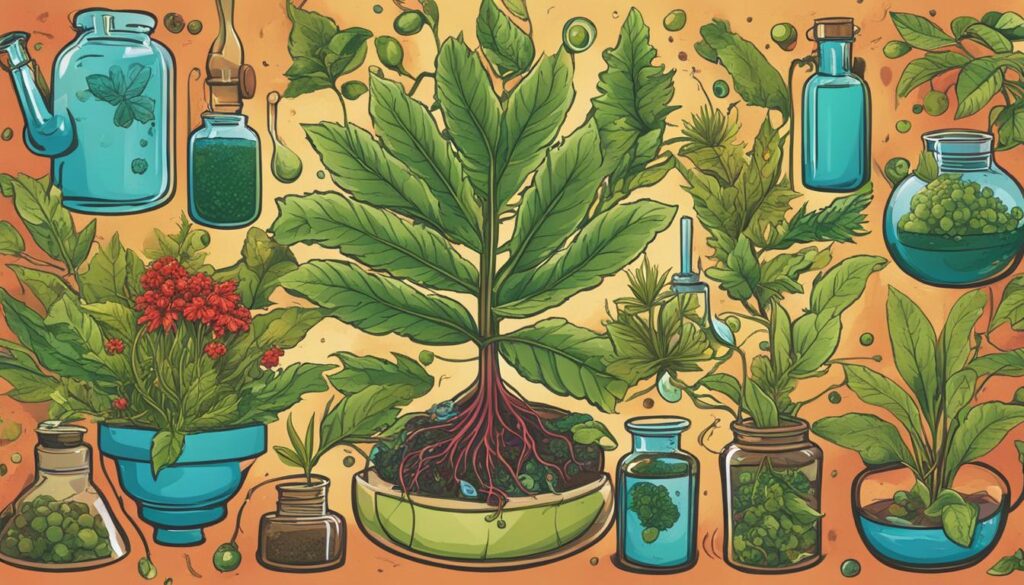
Antibiotic resistance is a growing concern globally, making it crucial to find effective alternatives. Plants possess an array of defense mechanisms, such as secondary metabolites, that can combat pathogens.
This article will explore the strongest medicinal plants with notable antibacterial properties, offering a natural solution to antibiotic resistance.
Medicinal plants have been used for centuries in traditional medicine to treat bacterial infections. These plants contain compounds that have demonstrated strong antimicrobial activity against various bacterial strains.
Examples include garlic, turmeric, oregano, and tea tree. Understanding the mechanisms of action of these antibacterial compounds can help in the development of new treatments.
Key Takeaways:
- Medicinal plants offer a natural solution to antibiotic resistance.
- Several plants, including garlic, turmeric, oregano, and tea tree, possess potent antibacterial properties.
- The compounds in these plants exert their effects through various mechanisms.
- Research supports the effectiveness of medicinal plants as antibacterial agents.
- Safety considerations and proper usage are essential when using medicinal plants.
Benefits of Using Herbal Remedies for Antibacterial Purposes
When it comes to combating bacterial infections, herbal remedies offer a range of benefits compared to conventional antibiotics. These natural alternatives provide a safer option with reduced risk of side effects and antibiotic resistance.
Also, many medicinal plants possess remarkable antimicrobial properties, making them effective against a wide range of bacterial pathogens.
Herbal remedies, also known as natural antibiotics, harness the power of plant-based compounds to fight off harmful bacteria.
Unlike synthetic antibiotics, these remedies work in harmony with the body’s natural processes and have been used for centuries in various traditional medicine practices. They offer a holistic approach to healing, targeting not only the infection but also supporting overall well-being.
One of the key advantages of herbal remedies is their broad-spectrum antimicrobial activity. Certain medicinal plants contain potent compounds that can inhibit the growth of different bacterial strains.
By utilizing these natural resources, healthcare professionals and individuals have access to a diverse range of options for treating bacterial infections.
Benefits of Using Herbal Remedies for Antibacterial Purposes:
- Natural alternatives to conventional antibiotics
- Reduced risk of side effects and antibiotic resistance
- Effective against a wide range of bacterial pathogens
- Broad-spectrum antimicrobial activity
Integrating herbal remedies into healthcare systems and promoting their use can lead to a more sustainable and holistic approach to antibacterial treatment. However, it is important to note that safety considerations should be taken into account, and healthcare professionals should be consulted for proper guidance and dosage recommendations.
Examples of Medicinal Plants with Potent Antibacterial Properties
Several medicinal plants have been found to exhibit potent antibacterial properties. These plants contain compounds that have demonstrated strong antimicrobial activity against various bacterial strains. Here are some examples:
Garlic (Allium sativum)
Garlic is well-known for its culinary uses, but it also possesses powerful antibacterial properties. Allicin, a compound found in garlic, has been shown to disrupt bacterial cell membranes, inhibiting their growth and survival.
Turmeric (Curcuma longa)
Turmeric is a bright yellow spice commonly used in traditional medicine. Curcumin, the active compound in turmeric, has been found to have potent antibacterial effects. It can inhibit the growth of various bacterial strains and has shown promise in treating antibiotic-resistant bacteria.
Oregano (Origanum vulgare)
Oregano is a popular herb used in cooking, and it also possesses strong antibacterial properties. It contains compounds such as carvacrol and thymol, which have been shown to have antimicrobial effects against a wide range of bacteria.
Tea Tree (Melaleuca alternifolia)
Tea tree oil, derived from the leaves of the tea tree plant, is widely known for its antibacterial properties. It contains terpenes, such as terpinen-4-ol, that have been shown to inhibit the growth of bacteria, including antibiotic-resistant strains.
These examples highlight the diverse range of medicinal plants that have potent antibacterial properties. Harnessing the power of these natural compounds can offer effective alternatives to conventional antibiotics, supporting the fight against antibiotic resistance.
Mechanisms of Action of Antibacterial Compounds in Medicinal Plants
Medicinal plants possess a rich array of compounds that exhibit antibacterial properties. These compounds work through various mechanisms to inhibit the growth and survival of bacterial pathogens. Understanding the mechanisms of action can provide valuable insights into how medicinal plants can be utilized for antibacterial purposes.
One mechanism of action is the disruption of bacterial cell membranes. Compounds such as allicin, found in garlic, have been shown to target and disrupt the integrity of bacterial cell membranes, leading to cell death. This mechanism prevents bacteria from proliferating and causing infections.
Another mechanism involves inhibiting specific enzymes or proteins that are essential for bacterial survival. For example, tea tree oil contains terpenes that can inhibit the activity of enzymes involved in bacterial replication and growth. By targeting these vital processes, medicinal plants disrupt the normal functioning of bacterial pathogens.
Additionally, some antibacterial compounds found in medicinal plants have the ability to interfere with the formation of biofilms, which are protective communities of bacteria. By disrupting biofilm formation, these compounds prevent bacteria from adhering to surfaces and forming colonies, making them more susceptible to other antibacterial treatments.
Table: Mechanisms of Action of Antibacterial Compounds in Medicinal Plants
| Compound | Mechanism of Action |
|---|---|
| Allicin (Garlic) | Disruption of bacterial cell membranes |
| Terpenes (Tea tree oil) | Inhibition of bacterial enzyme activity |
| Phenolic compounds (Oregano) | Disruption of biofilm formation |
These are just a few examples of the diverse mechanisms utilized by antibacterial compounds in medicinal plants. By targeting different aspects of bacterial physiology, these compounds provide a multi-faceted approach to combating bacterial infections.

Research supporting the effectiveness of medicinal plants as antibacterial agents
Scientific research has demonstrated the effectiveness of medicinal plants as potent antibacterial agents. These studies have provided valuable insights into the antimicrobial properties of various plant extracts, offering promising alternatives to conventional antibiotics.
One study published in the Journal of Ethnopharmacology investigated the antibacterial activity of Echinacea extracts against a range of bacterial strains. The results showed significant inhibitory effects, highlighting the potential of Echinacea as a natural antibacterial agent.
In another study published in the International Journal of Antimicrobial Agents, scientists explored the antibacterial properties of ginger and neem extracts. The findings revealed strong antimicrobial activity against multiple bacteria, further supporting the use of these medicinal plants in the treatment of bacterial infections.
| Medicinal Plant | Research Findings |
|---|---|
| Echinacea | Significant inhibitory effects against bacterial strains |
| Ginger and neem | Strong antimicrobial activity against multiple bacteria |
These research findings provide scientific evidence supporting the effectiveness of medicinal plants as antibacterial agents. By harnessing the power of nature, these plant-based remedies offer a natural and sustainable approach to combating bacterial infections.
Traditional Uses of Medicinal Plants for Treating Bacterial Infections
The utilization of medicinal plants for treating bacterial infections can be traced back centuries, with traditional practices recognizing the therapeutic properties of various plant species.
These plants have been revered for their ability to combat bacterial pathogens, providing effective remedies for a range of infections. Through generations of empirical knowledge and experimentation, traditional medicine systems around the world have identified specific plants that possess potent antibacterial properties.
In traditional Chinese medicine, for example, aloe vera (Aloe barbadensis) has been used to treat wounds and skin infections due to its antimicrobial and healing properties.
Thyme (Thymus vulgaris), a common herb in Mediterranean and Middle Eastern cuisines, has also been traditionally employed to fight respiratory and gastrointestinal infections caused by bacteria.
Sage (Salvia officinalis), another widely recognized medicinal plant, has been utilized for its antibacterial effects against bacterial strains such as Escherichia coli and Staphylococcus aureus.
Native American tribes have long relied on the medicinal properties of plants such as yarrow (Achillea millefolium) and echinacea (Echinacea purpurea) to combat bacterial infections.
Yarrow was traditionally used for wound healing and to alleviate symptoms of respiratory infections, while echinacea was recognized for its immune-stimulating properties and its ability to prevent bacterial growth.
These examples illustrate the diverse array of medicinal plants and their traditional uses in different cultures for treating bacterial infections.
| Traditional Medicinal Plant | Traditional Use |
|---|---|
| Aloe vera (Aloe barbadensis) | Treating wounds and skin infections |
| Thyme (Thymus vulgaris) | Combatting respiratory and gastrointestinal infections |
| Sage (Salvia officinalis) | Antibacterial effects against Escherichia coli and Staphylococcus aureus |
| Yarrow (Achillea millefolium) | Wound healing and respiratory infection relief |
| Echinacea (Echinacea purpurea) | Immune stimulation and prevention of bacterial growth |
The knowledge of traditional uses of these medicinal plants for treating bacterial infections not only highlights their historical significance but also reinforces their potential as effective natural alternatives to conventional antibiotics.
While scientific research continues to shed light on the mechanisms and efficacy of these traditional remedies, their time-tested usage serves as a testament to their value in combating bacterial pathogens.
Challenges and Limitations in Using Medicinal Plants for Antibacterial Purposes
While medicinal plants offer promising alternatives for antibacterial treatment, there are challenges and limitations to consider. These factors can impact the efficacy and safety of using medicinal plants as antibacterial agents.
One of the primary challenges is the variability in plant quality. The potency of medicinal plants can vary depending on various factors such as soil conditions, climate, and cultivation practices. This variability can affect the concentration of active compounds responsible for the antibacterial properties, leading to inconsistent results.
Another limitation is the inconsistent dosage of medicinal plants. Unlike conventional antibiotics, which have precise dosage instructions, medicinal plants often require trial and error to determine the appropriate dosage for each individual and condition.
This uncertainty in dosing can hinder the effectiveness of treatment and pose risks of under or overuse.
Furthermore, the limited availability of certain medicinal plants can be a constraint. Some plants may only grow in specific regions or have limited cultivation, making them less accessible for widespread use. This limitation can restrict the availability of potential antibacterial treatments derived from medicinal plants.
| Challenges in Using Medicinal Plants | Limited Availability | Inconsistent Dosage | Variability in Plant Quality |
|---|---|---|---|
| Impact on the efficacy and safety of using medicinal plants as antibacterial agents. | Some plants may only grow in specific regions or have limited cultivation. | Determining the appropriate dosage for each individual and condition can be a challenge. | Potency of medicinal plants can vary depending on various factors, leading to inconsistent results. |
Future prospects and potential applications of antibacterial medicinal plants
The use of antibacterial medicinal plants holds great promise for the future. Ongoing research and development efforts aim to uncover new plant-based compounds with enhanced antibacterial properties, paving the way for novel treatments in the fight against bacterial infections and antibiotic resistance.
By harnessing the power of nature, medicinal plants offer a sustainable and effective solution to combat bacteria.
Expanding the scope: From traditional medicine to alternative therapies
As our understanding of the therapeutic potential of medicinal plants grows, there is an opportunity to explore their applications beyond traditional medicine.
Integrating these plants into various healthcare practices, such as wound dressings, antimicrobial textiles, and alternative therapies, can expand their potential applications and improve patient outcomes.
For example, incorporating antibacterial medicinal plants into wound dressings may help prevent infection and promote faster healing.
Addressing global health challenges
Medicinal plants have the potential to address some of the pressing global health challenges we face today. With the rise of antibiotic resistance and the need for effective alternatives, antibacterial medicinal plants offer a ray of hope.
By leveraging their potent antimicrobial properties, these plants can be harnessed to develop new treatments that combat drug-resistant bacteria.
The use of medicinal plants may help reduce healthcare costs associated with antibiotic resistance, providing a cost-effective solution for healthcare systems worldwide.
| Table: Potential applications of antibacterial medicinal plants | |
|---|---|
| Application | Potential Benefits |
| Wound dressings | Preventing infection and promoting faster healing |
| Antimicrobial textiles | Reducing the growth of bacteria on fabrics, especially in healthcare settings |
| Alternative therapies | Providing natural and holistic approaches to managing bacterial infections |
| Pharmaceutical development | Creating new antibacterial drugs and treatments |
Unlocking the full potential of antibacterial medicinal plants requires further scientific exploration, investment, and collaboration between researchers, healthcare professionals, and the pharmaceutical industry.
By tapping into the power of nature, we can discover new solutions to combat bacterial infections and pave the way for a healthier future.
Safety Considerations When Using Medicinal Plants as Antibacterial Agents
When utilizing medicinal plants as antibacterial agents, it is important to prioritize safety considerations. While these natural remedies offer promising alternatives to conventional antibiotics, proper identification and usage are essential to avoid any potential adverse effects.
Consulting with healthcare professionals and following recommended dosage guidelines ensure the safe and effective use of medicinal plants.
One key safety consideration is the accurate identification of plants. Mistaking a toxic plant for a medicinal one can have serious consequences. Therefore, it is crucial to seek guidance from experts or refer to reliable sources for plant identification.
It is advisable to source medicinal plants from reputable suppliers or cultivate them in controlled environments to ensure their quality and integrity.
Another important safety consideration is understanding the appropriate dosage for each medicinal plant. Dosage recommendations can vary based on factors such as age, health condition, and the specific antibacterial purpose.
It is crucial to consult with healthcare professionals who are knowledgeable in herbal medicine to determine the correct dosage for optimal efficacy and safety.
| Safety Considerations When Using Medicinal Plants as Antibacterial Agents | Action Steps |
|---|---|
| Accurate plant identification | Consult experts or reliable sources for identification |
| Sourcing from reputable suppliers | Ensure quality and authenticity of medicinal plants |
| Dosage determination | Consult healthcare professionals for appropriate dosage |
| Adverse effects monitoring | Be aware of any allergic reactions or side effects |
| Pregnancy and breastfeeding considerations | Consult healthcare professionals regarding safety during these periods |
| Interactions with medications | Take into account potential interactions with existing medications |
Monitoring for any adverse effects is crucial when using medicinal plants. Allergic reactions or side effects should be promptly reported to healthcare professionals to ensure appropriate action is taken. If any negative symptoms occur, it is important to discontinue the use of the medicinal plant and seek medical advice.
Furthermore, special considerations should be given to the use of medicinal plants during pregnancy and breastfeeding, as their safety in these situations may vary. It is essential to consult healthcare professionals for guidance on which medicinal plants are safe to use during these periods.
Lastly, it is important to be aware of potential interactions between medicinal plants and existing medications. Some medicinal plants may interact with certain medications, reducing their effectiveness or causing adverse reactions.
It is advisable to inform healthcare professionals of any medications being taken to ensure safe and appropriate use of medicinal plants as antibacterial agents.
Integrating Medicinal Plants into Healthcare Systems for Antibacterial Treatment
The use of medicinal plants for antibacterial treatment can be a valuable addition to healthcare systems, providing a holistic and sustainable approach.
By integrating traditional and complementary medicine practices, healthcare providers can harness the benefits of medicinal plants while ensuring proper regulation and quality control.
This integration allows for a more comprehensive approach to antibacterial treatment, addressing the challenges of antibiotic resistance while providing effective alternatives.
Integrating medicinal plants into healthcare systems involves several key considerations. First, it is essential to establish standardized protocols for the identification, cultivation, and preparation of medicinal plants.
This ensures consistent quality and potency of the plant-based remedies used in antibacterial treatment. Additionally, healthcare providers must collaborate with traditional healers and experts in ethnobotany to gain a deeper understanding of traditional uses and dosage recommendations.
Education and training for healthcare professionals are crucial in order to effectively incorporate medicinal plants into existing healthcare practices.
This includes understanding the mechanisms of action of antibacterial compounds found in plants, as well as potential interactions with conventional medications. By equipping healthcare providers with the necessary knowledge and skills, the safe and effective use of medicinal plants as antibacterial agents can be optimized.
The integration of medicinal plants into healthcare systems extends beyond the treatment of bacterial infections. These plants have the potential to be incorporated into various aspects of healthcare, such as preventive care, wound healing, and supportive therapies.
For example, antimicrobial textiles infused with plant extracts can help prevent the spread of bacterial infections in healthcare settings. Alternative therapies utilizing medicinal plants, such as aromatherapy and herbal formulations, can also be explored to enhance overall patient well-being.
| Benefits of Integrating Medicinal Plants into Healthcare Systems for Antibacterial Treatment | Challenges in Integrating Medicinal Plants into Healthcare Systems for Antibacterial Treatment |
|---|---|
|
|
The integration of medicinal plants into healthcare systems for antibacterial treatment offers a promising path forward in addressing antibiotic resistance and promoting sustainable healthcare practices.
By harnessing the power of nature and combining it with modern medicine, healthcare providers can offer effective and holistic solutions for bacterial infections.

Conclusion: Harnessing the Power of Medicinal Plants for Antibacterial Purposes
Throughout this article, I have explored the remarkable potential of medicinal plants as powerful antibacterial agents. With the rise of antibiotic resistance and the need for effective alternatives, these plants offer a natural solution to combat bacterial infections.
Through their strong antibacterial properties, medicinal plants have the ability to support human health and contribute to the fight against antibiotic resistance.
Research has shown that various medicinal plants, such as garlic, turmeric, oregano, and tea tree, possess potent antibacterial compounds that can inhibit the growth of bacterial pathogens.
These natural alternatives to conventional antibiotics not only provide effective treatment options but also minimize the risks of side effects and antibiotic resistance.
Furthermore, the traditional uses of medicinal plants in treating bacterial infections across different cultures further validate their antibacterial properties.
Incorporating medicinal plants into healthcare systems and developing standardized preparations can ensure their safe and effective use as antibacterial agents.
The future prospects of medicinal plants for antibacterial purposes are promising. Ongoing research and development may lead to the discovery of new plant-based compounds with enhanced antibacterial properties.
Moreover, integrating medicinal plants into various applications, such as wound dressings and antimicrobial textiles, can further expand their potential uses.
Medicinal plants possess the power to combat bacterial infections and address the challenges of antibiotic resistance. With their potent antibacterial properties, traditional uses, and future potential, these plants have the capacity to make a significant impact on human health.
By continuing to explore and integrate medicinal plants into healthcare systems, we can harness their full potential for antibacterial purposes.
FAQ
What are the benefits of using herbal remedies for antibacterial purposes?
Herbal remedies offer natural alternatives to conventional antibiotics, reducing the risk of side effects and antibiotic resistance. Many medicinal plants possess antimicrobial properties, making them effective against a wide range of bacterial pathogens.
Which medicinal plants have the strongest antibacterial properties?
Some examples of medicinal plants with potent antibacterial properties include garlic (Allium sativum), turmeric (Curcuma longa), oregano (Origanum vulgare), and tea tree (Melaleuca alternifolia). These plants contain compounds that have demonstrated strong antimicrobial activity against various bacterial strains.
How do antibacterial compounds in medicinal plants work?
The antibacterial compounds found in medicinal plants exert their effects through various mechanisms. For example, garlic contains allicin, which disrupts bacterial cell membranes. Tea tree oil contains terpenes that inhibit bacterial growth.
Is there scientific evidence supporting the effectiveness of medicinal plants as antibacterial agents?
Numerous studies have investigated the antibacterial properties of medicinal plants and have found promising results. Research has shown that extracts from plants such as Echinacea, ginger, and neem possess significant antibacterial activity, providing scientific evidence supporting the effectiveness of medicinal plants as antibacterial agents.
Have medicinal plants been traditionally used for treating bacterial infections?
Yes, medicinal plants have been used for centuries in traditional medicine to treat bacterial infections. Traditional practices in various cultures have identified plants such as aloe vera, thyme, and sage as effective remedies for combating bacterial pathogens, further validating the antibacterial properties of medicinal plants.
What are the challenges and limitations in using medicinal plants for antibacterial purposes?
Challenges and limitations include variability in plant quality, inconsistent dosage, and limited availability. Additionally, the development of standardized preparations and adherence to safety guidelines are important for ensuring the efficacy and safety of using medicinal plants for antibacterial purposes.
What are the future prospects and potential applications of antibacterial medicinal plants?
The use of antibacterial medicinal plants holds great potential for the future. Further research and development can lead to the discovery of new plant-based compounds with enhanced antibacterial properties. Additionally, incorporating medicinal plants into various applications such as wound dressings, antimicrobial textiles, and alternative therapies can expand their potential applications.
What safety considerations should be taken when using medicinal plants as antibacterial agents?
Safety is an important consideration when using medicinal plants as antibacterial agents. It is crucial to properly identify and use plants to avoid potential adverse effects. Consulting with healthcare professionals and following recommended dosage guidelines are essential for ensuring the safe and effective use of medicinal plants.
How can medicinal plants be integrated into healthcare systems for antibacterial treatment?
The integration of medicinal plants into healthcare systems can provide a holistic and sustainable approach to antibacterial treatment. By incorporating traditional and complementary medicine practices, healthcare systems can harness the benefits of medicinal plants while ensuring proper regulation and quality control.
What is the conclusion on harnessing the power of medicinal plants for antibacterial purposes?
Medicinal plants offer a valuable resource for combating bacterial infections and addressing the challenges of antibiotic resistance. With their potent antibacterial properties, traditional uses, and future potential, medicinal plants have the ability to play a significant role in supporting human health. Continued research and integration into healthcare systems can further harness the power of medicinal plants for antibacterial purposes.







2 Comments
Comments are closed.